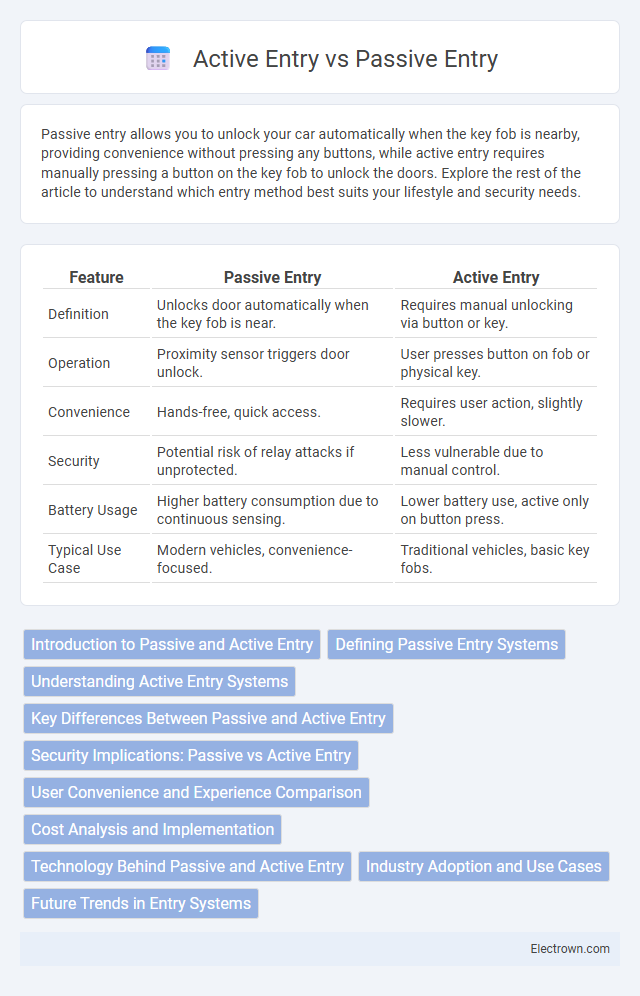Passive entry allows you to unlock your car automatically when the key fob is nearby, providing convenience without pressing any buttons, while active entry requires manually pressing a button on the key fob to unlock the doors. Explore the rest of the article to understand which entry method best suits your lifestyle and security needs.
Table of Comparison
| Feature | Passive Entry | Active Entry |
|---|---|---|
| Definition | Unlocks door automatically when the key fob is near. | Requires manual unlocking via button or key. |
| Operation | Proximity sensor triggers door unlock. | User presses button on fob or physical key. |
| Convenience | Hands-free, quick access. | Requires user action, slightly slower. |
| Security | Potential risk of relay attacks if unprotected. | Less vulnerable due to manual control. |
| Battery Usage | Higher battery consumption due to continuous sensing. | Lower battery use, active only on button press. |
| Typical Use Case | Modern vehicles, convenience-focused. | Traditional vehicles, basic key fobs. |
Introduction to Passive and Active Entry
Passive entry systems automatically unlock a vehicle when the key fob is within proximity, enhancing convenience and security without requiring manual interaction. Active entry systems demand the user to physically press a button on the key fob or door handle to unlock the vehicle, ensuring deliberate access control. Both technologies integrate wireless communication protocols such as RFID or Bluetooth Low Energy to enable keyless vehicle access.
Defining Passive Entry Systems
Passive entry systems enable you to unlock and start your vehicle without physically using a key or pressing a button, relying instead on sensors that detect the presence of an authorized key fob nearby. These systems automatically grant access by recognizing your proximity, enhancing convenience and security through encrypted communication between the vehicle and the key fob. Unlike active entry methods that require manual interaction, passive entry streamlines entry and ignition processes by eliminating the need for direct user input.
Understanding Active Entry Systems
Active entry systems require users to physically unlock their vehicle using a remote key fob or by pressing a button on the door handle, providing deliberate control over access. These systems rely on signal transmission and user interaction, enhancing security by preventing unauthorized entry without intentional activation. Active entry technology often includes features such as remote start and lock confirmation, improving convenience and user experience.
Key Differences Between Passive and Active Entry
Passive entry systems unlock your vehicle automatically when the key fob is within proximity, enhancing convenience and reducing the need for manual input. Active entry requires pressing a button on the key fob or door handle to unlock the car, offering more control over access. Key differences include the level of user interaction, speed of access, and battery consumption, with passive entry being more seamless but potentially draining the key fob battery faster.
Security Implications: Passive vs Active Entry
Passive entry systems automatically unlock the vehicle when the key fob is nearby, reducing the risk of key misplacement but increasing vulnerability to relay attacks that intercept the fob's signal. Active entry requires manual pressing of a button or key fob, providing an extra layer of user verification but may be less convenient. Understanding security implications involves balancing convenience with risks such as signal amplification and unauthorized access.
User Convenience and Experience Comparison
Passive entry systems enhance user convenience by allowing you to unlock and start your vehicle without physically using a key or pressing buttons, offering seamless and quick access. Active entry requires manual interaction, such as pressing a button on the key fob or the car door, which can be less convenient in situations where your hands are full or in adverse weather conditions. Overall, passive entry improves user experience by providing effortless access and reducing time spent on vehicle entry, making daily routines smoother.
Cost Analysis and Implementation
Passive entry systems typically incur higher upfront costs due to advanced sensors and key fob technology, whereas active entry solutions generally feature lower hardware expenses but require manual interaction, such as pressing a button. Implementation of passive entry involves more complex integration with vehicle electronics and security protocols, resulting in longer installation times and increased labor costs compared to the simpler wiring and programming involved in active entry systems. Cost analysis favors active entry for budget-conscious projects, while passive entry offers enhanced user convenience and security that justifies its premium price in luxury and high-end markets.
Technology Behind Passive and Active Entry
Passive entry systems utilize proximity sensors and encrypted radio frequency identification (RFID) signals to detect a key fob near the vehicle, enabling automatic unlocking without physical interaction. Active entry requires the user to physically press a button on the key fob or door handle, triggering a wireless command that initiates unlocking through Bluetooth or RF communication protocols. Both technologies leverage advanced microcontrollers and secure cryptographic algorithms to ensure authentication and prevent unauthorized access.
Industry Adoption and Use Cases
Passive entry systems have gained widespread industry adoption in automotive brands, offering convenience and security by automatically unlocking doors as you approach, making them ideal for everyday personal vehicles and luxury models. Active entry systems require deliberate user interaction, such as pressing a button on a key fob, and are commonly used in fleet management and environments demanding enhanced access control. Your choice between passive and active entry depends on use cases ranging from seamless user experience in consumer vehicles to stringent security requirements in commercial applications.
Future Trends in Entry Systems
Future trends in entry systems emphasize seamless user experience through advanced passive entry technologies, such as contactless key fobs and smartphone integration, reducing the need for manual interaction. Enhanced security features like biometric authentication combined with active entry protocols will offer greater protection against unauthorized access. Your vehicle access will become increasingly intuitive, leveraging IoT connectivity and AI-powered systems to anticipate user presence and preferences.
Passive entry vs Active entry Infographic

 electrown.com
electrown.com